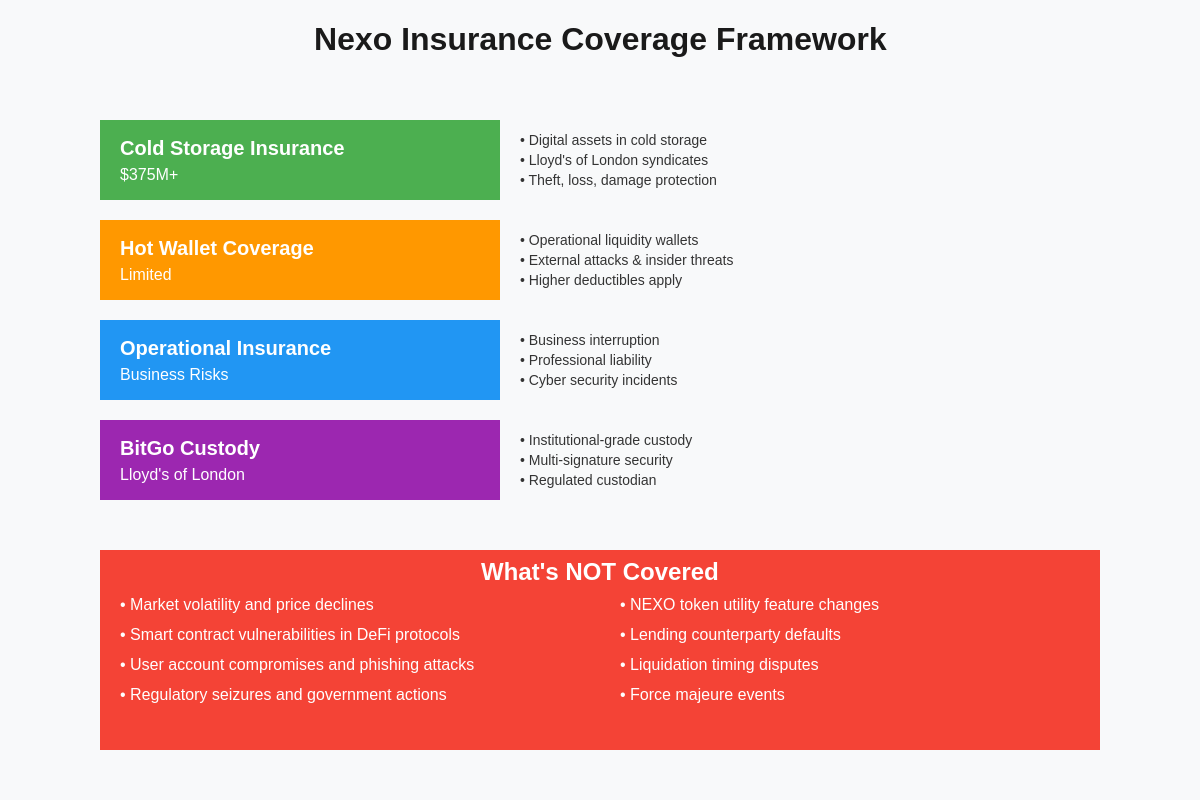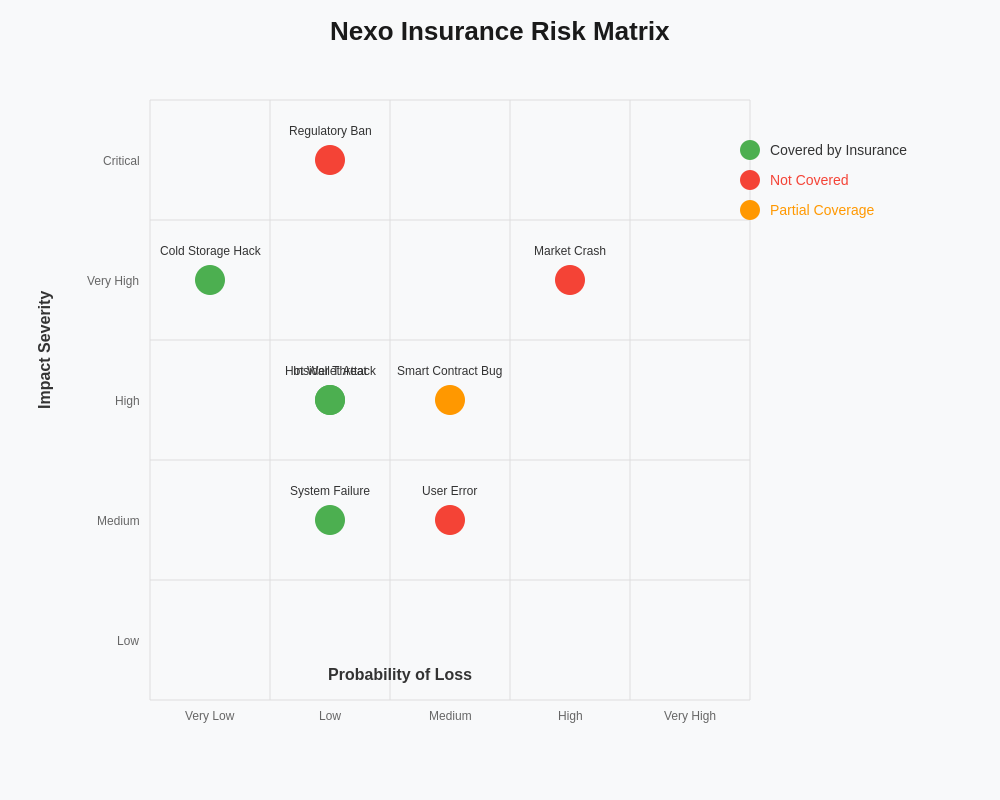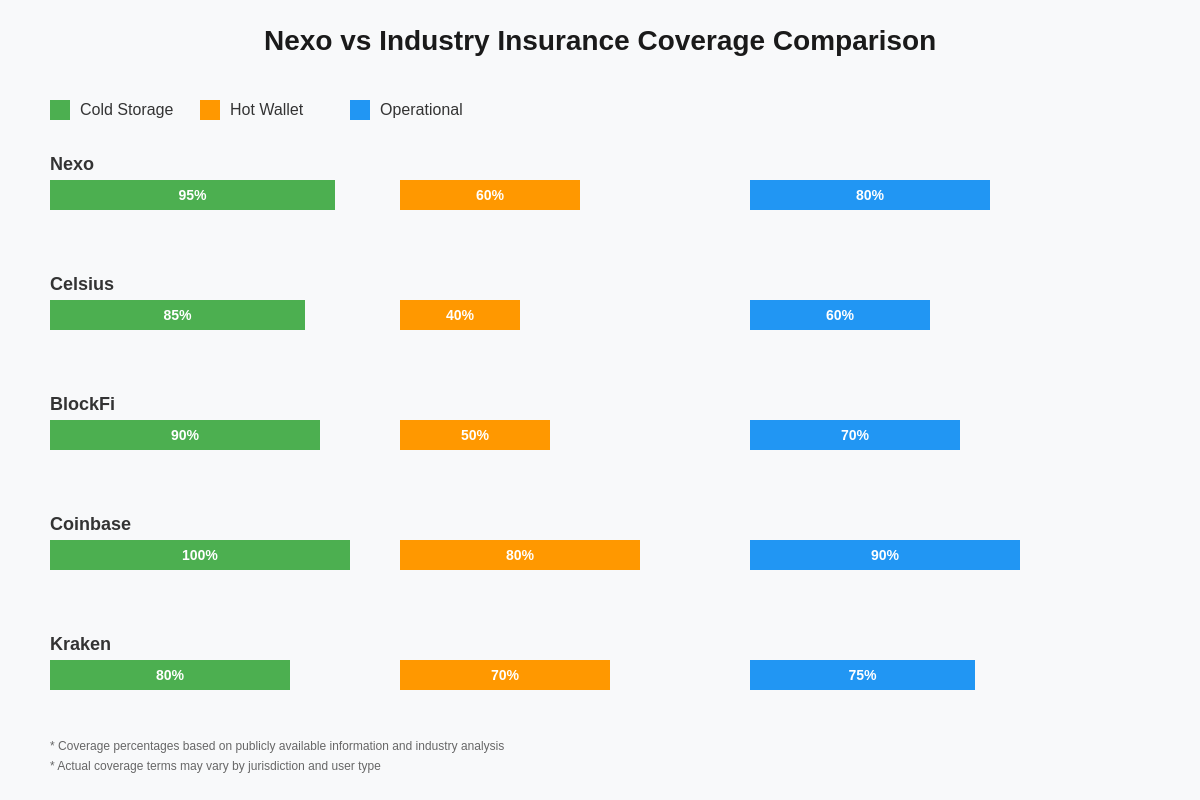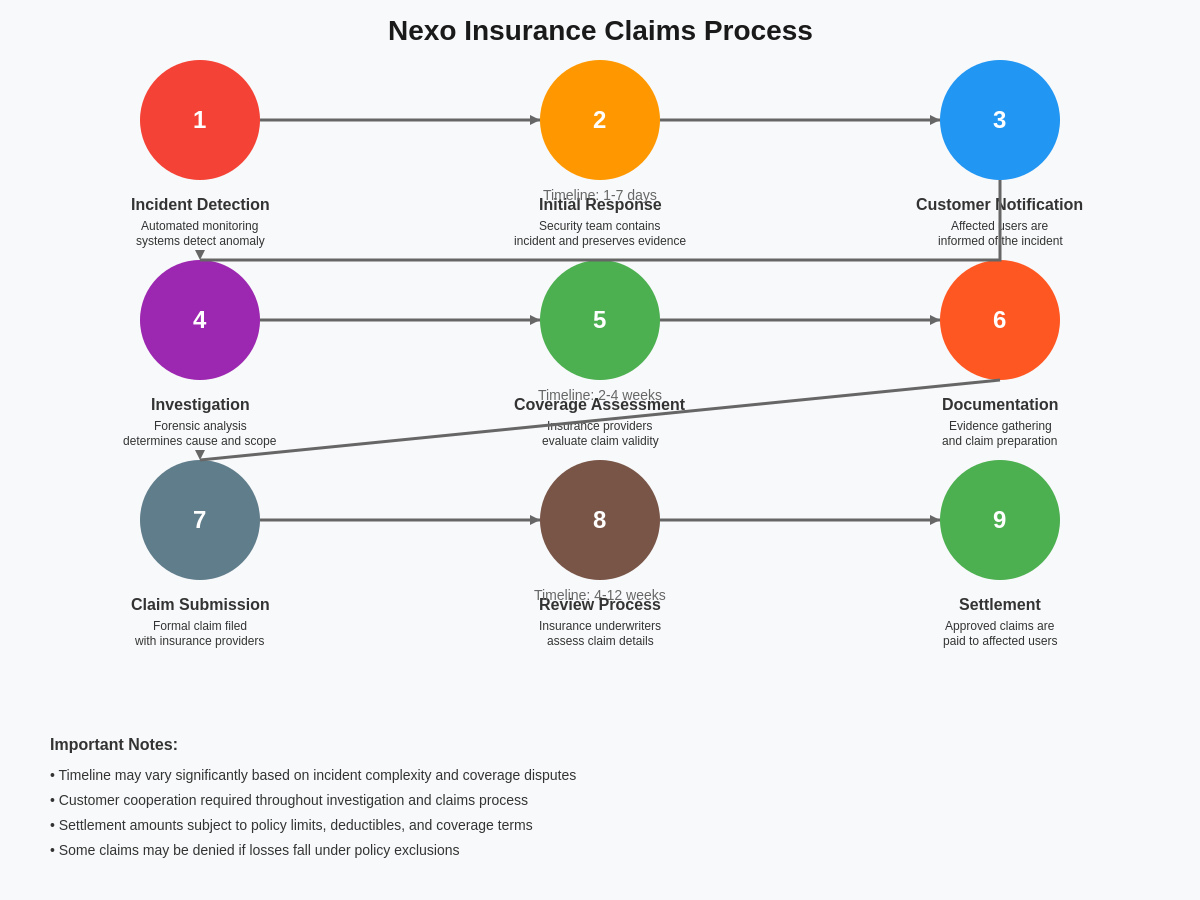Comprehensive crypto trading analysis and strategies
Understanding Nexo’s Multi-Layered Insurance Framework
Nexo has established itself as one of the leading cryptocurrency lending and financial services platforms, with over $15 billion in assets under management and a comprehensive insurance framework designed to protect customer funds across multiple risk scenarios. The platform’s insurance coverage represents a sophisticated multi-layered approach that combines traditional insurance products with specialized cryptocurrency coverage, creating what the company claims is one of the most robust protection systems in the digital asset industry.

The complexity of Nexo’s insurance framework reflects the unique challenges facing cryptocurrency financial service providers, where traditional banking insurance models must be adapted to address the specific risks associated with digital asset custody, smart contract operations, and the rapidly evolving regulatory landscape. Understanding exactly what is and isn’t covered under Nexo’s various insurance policies requires careful examination of the different layers of protection and the specific circumstances under which coverage applies.
Nexo’s insurance strategy encompasses multiple insurance providers and coverage types, including custodial insurance for digital assets held in cold storage, operational insurance covering various business risks, and specialized coverage for specific aspects of their lending and trading operations. This multi-provider approach is designed to eliminate single points of failure in insurance coverage while ensuring comprehensive protection across the full spectrum of risks associated with cryptocurrency financial services.
Digital Asset Custody Insurance Coverage
The cornerstone of Nexo’s insurance framework is their digital asset custody insurance, which provides coverage for cryptocurrency holdings stored in their institutional-grade custody solution through BitGo. This coverage, underwritten by Lloyd’s of London syndicates, protects against theft, loss, or damage of digital assets resulting from various security breaches and operational failures, representing one of the largest cryptocurrency insurance policies in the industry.
The custody insurance specifically covers digital assets held in cold storage systems, which represents the majority of customer funds held by Nexo. Cold storage systems, while generally considered the most secure method for cryptocurrency storage, still face risks from physical theft, natural disasters, insider threats, and technical failures that could result in permanent loss of access to digital assets. The insurance coverage is designed to compensate customers for losses resulting from these specific risk scenarios.
Coverage limits under the custody insurance policy are substantial, though Nexo has not disclosed the exact dollar amounts to prevent providing information that could be useful to potential attackers. The coverage applies to a wide range of digital assets supported by the platform, including Bitcoin, Ethereum, and various altcoins, with coverage amounts typically based on the market value of assets at the time of loss. However, customers should understand that coverage may be subject to deductibles, waiting periods, and other standard insurance policy provisions.
The custody insurance operates on a pooled basis, meaning that individual customer losses are covered from the overall insurance pool rather than through individual policies for each customer. This approach allows for more comprehensive coverage at lower overall costs while ensuring that individual customers are not responsible for purchasing their own insurance coverage for assets held on the platform.
Hot Wallet and Operational Coverage
While the majority of customer funds are held in insured cold storage, Nexo maintains hot wallets for operational purposes including processing withdrawals, facilitating trades, and managing liquidity across various cryptocurrency networks. Hot wallet insurance coverage represents a more complex challenge due to the connected nature of these systems and their exposure to various online attack vectors.
Nexo’s hot wallet insurance coverage is designed to protect against unauthorized access, theft, and other security breaches that could result in loss of digital assets from online storage systems. This coverage includes protection against external attacks such as hacking attempts, as well as internal threats including employee fraud and system misuse. The coverage extends to operational errors that could result in asset loss, including technical failures in withdrawal processing and smart contract interactions.
The scope of hot wallet coverage includes both the direct theft of digital assets and the costs associated with incident response, forensic investigation, and system restoration following a security breach. This comprehensive approach ensures that the platform can maintain operations and protect customer interests even in the event of significant security incidents affecting hot wallet systems.
However, hot wallet insurance coverage typically involves higher deductibles and more restrictive terms compared to cold storage coverage, reflecting the increased risk profile of connected systems. Customers should understand that hot wallet coverage may be subject to more stringent policy conditions and may not cover all types of operational losses or technical failures that could affect hot wallet systems.
What’s NOT Covered: Critical Exclusions and Limitations
Understanding what is not covered under Nexo’s insurance policies is equally important as understanding what is protected, as these exclusions define the residual risks that customers must accept when using the platform. Market risk represents the most significant exclusion from insurance coverage, meaning that declines in cryptocurrency values due to market conditions, regulatory changes, or other macroeconomic factors are not covered under any insurance policy.

Smart contract risks associated with DeFi integrations and yield generation strategies employed by Nexo are generally not covered under traditional insurance policies. While Nexo implements extensive security auditing and risk management procedures for smart contract interactions, the experimental nature of DeFi protocols means that unexpected vulnerabilities or attack vectors could result in losses that are not covered by insurance.
User-related security breaches, including losses resulting from compromised user accounts, phishing attacks, social engineering, or user error in managing their Nexo account credentials, are typically excluded from insurance coverage. Customers remain responsible for maintaining the security of their account access credentials and following recommended security practices to protect their accounts from unauthorized access.
Regulatory risks, including potential losses resulting from changes in cryptocurrency regulations, government seizures, or legal restrictions on cryptocurrency operations, are generally excluded from insurance coverage. While Nexo maintains comprehensive compliance programs and legal reserves, the evolving regulatory landscape for cryptocurrencies means that certain regulatory scenarios could result in operational restrictions or asset freezes that would not be covered by insurance.
Nexo Token and Platform-Specific Risks
The insurance coverage for Nexo’s native token (NEXO) involves additional complexities due to its dual role as both a cryptocurrency asset and a utility token within the Nexo ecosystem. While NEXO tokens held in custody are generally covered under the same digital asset insurance policies as other cryptocurrencies, certain platform-specific risks and use cases may not be fully covered.
The value proposition of NEXO tokens is partially derived from their utility within the Nexo platform, including benefits such as enhanced yield rates, reduced borrowing costs, and dividend distributions. Insurance coverage typically does not extend to the loss of these utility benefits or changes in token economics that could affect the value or functionality of NEXO tokens within the platform ecosystem.
Platform-specific risks affecting NEXO tokens include potential changes to the token’s utility features, modifications to the dividend distribution mechanism, or alterations to the loyalty program benefits that provide much of the token’s value proposition. These business model risks are generally not covered under insurance policies, as they relate to the operational decisions and strategic direction of the company rather than security breaches or custodial failures.
Liquidity risks affecting NEXO tokens, particularly during periods of market stress or platform operational difficulties, may not be fully addressed through insurance coverage. While insurance can protect against theft or loss of tokens, it cannot guarantee market liquidity or trading availability during periods when these services may be most needed by token holders.
Lending and Borrowing Coverage Limitations
Nexo’s core business model involves cryptocurrency lending and borrowing services, which introduce specific risks that may not be fully covered under standard insurance policies. Credit risk associated with institutional borrowers and counterparty risk from various financial partnerships represent significant operational risks that are typically managed through diversification and collateralization rather than insurance coverage.
The lending operations expose the platform to liquidation risks during periods of extreme market volatility, when rapid price movements could result in insufficient collateral coverage for outstanding loans. While Nexo implements sophisticated risk management systems and maintains insurance coverage for custodial operations, the insurance may not cover losses resulting from inadequate liquidation procedures or extreme market conditions that prevent effective risk management.
Interest rate risks and yield generation risks associated with various cryptocurrency investment strategies employed by Nexo may not be covered under insurance policies. The platform’s ability to generate yields for customers depends on successful deployment of funds across various DeFi protocols, lending markets, and trading strategies, all of which involve risks that are typically managed through diversification rather than insurance coverage.
Borrowers using Nexo’s credit facilities should understand that their collateral remains subject to the same insurance coverage and exclusions as other customer funds, but that credit-related disputes, liquidation procedures, and collateral management decisions are governed by the platform’s terms of service rather than insurance policies. This means that disagreements about liquidation timing, collateral valuations, or credit terms would be resolved through the platform’s dispute resolution procedures rather than insurance claims.
Regulatory Compliance and Geographic Coverage
The geographic scope of Nexo’s insurance coverage varies based on regulatory requirements and insurance provider limitations, with different levels of protection available to customers in different jurisdictions. Customers in certain regions may have access to additional protections through local regulatory frameworks, while others may face limitations on coverage availability due to regulatory restrictions on cryptocurrency insurance products.
European customers benefit from Nexo’s comprehensive regulatory compliance framework, including segregation of customer funds and adherence to strict operational standards that provide additional protections beyond insurance coverage. However, the specific terms of insurance coverage may vary based on local regulations and the availability of cryptocurrency insurance products in different European Union member states.
United States customers face additional complexities due to the fragmented regulatory landscape for cryptocurrency services, with different states imposing varying requirements on cryptocurrency custody and insurance coverage. Nexo’s compliance with state-level regulations and money transmission licensing requirements provides some additional protections, but customers should understand that regulatory coverage may not be equivalent to insurance coverage.
The evolving nature of cryptocurrency regulations means that insurance coverage terms and availability may change based on new regulatory requirements or changes in the legal status of cryptocurrency operations in different jurisdictions. Customers should stay informed about regulatory developments in their jurisdictions and understand how these changes might affect their insurance coverage and legal protections.
Comparison with Industry Standards
When evaluated against industry standards for cryptocurrency insurance coverage, Nexo’s insurance framework represents one of the more comprehensive approaches available in the cryptocurrency financial services sector. The combination of Lloyd’s of London backing, BitGo custody integration, and multi-layered coverage provides protection levels that exceed those offered by many smaller cryptocurrency platforms and traditional exchanges.

However, comparison with traditional banking insurance reveals significant gaps in coverage scope and consumer protections that reflect the early stage of cryptocurrency insurance product development. Traditional banking customers benefit from government-backed deposit insurance, comprehensive regulatory oversight, and established legal frameworks for dispute resolution that are not yet fully developed in the cryptocurrency sector.
The cryptocurrency industry has seen significant improvements in insurance coverage availability and terms over the past several years, driven by increased institutional participation and the development of specialized insurance products by major insurance providers. Nexo’s insurance framework reflects these industry developments while highlighting the ongoing challenges in providing comprehensive protection for cryptocurrency financial services.
When comparing insurance coverage across different cryptocurrency platforms, customers should consider not only the dollar amounts of coverage but also the scope of protection, the reputation and financial strength of insurance providers, the transparency of coverage terms, and the track record of successful claims processing. These factors collectively determine the practical value of insurance coverage in protecting customer interests.
Claims Process and Incident Response
The process for filing insurance claims related to Nexo’s coverage involves multiple stakeholders including Nexo itself, the custody provider BitGo, and the various insurance companies providing coverage. Understanding this process is crucial for customers who want to know how they would be protected in the event of a covered loss and what steps would be required to recover their assets.

Initial incident detection and response procedures are designed to minimize losses and preserve evidence necessary for insurance claims processing. Nexo maintains comprehensive monitoring systems and incident response protocols that are designed to quickly identify and contain security breaches or operational failures that could result in customer losses. The speed and effectiveness of this initial response can significantly impact both the extent of losses and the success of subsequent insurance claims.
The claims investigation process typically involves forensic analysis of the incident, assessment of the extent of losses, and determination of coverage applicability under the relevant insurance policies. This process can be time-consuming and may require customers to provide documentation and cooperation with investigators, particularly in cases involving disputed or complex loss scenarios.
Customer communication during the claims process is managed through Nexo’s customer support systems, with regular updates provided on the status of investigations and expected timelines for resolution. However, customers should understand that insurance claims processing can involve significant delays, particularly for large or complex claims that require extensive investigation and documentation.
Future Evolution of Coverage
The insurance landscape for cryptocurrency financial services continues to evolve rapidly, with new products, providers, and coverage types being developed to address the unique risks associated with digital asset operations. Nexo’s insurance framework is likely to continue evolving as new risks emerge, regulatory requirements change, and insurance products become more sophisticated and comprehensive.
Emerging risks in the cryptocurrency sector, including quantum computing threats, new attack vectors targeting DeFi protocols, and evolving regulatory requirements, will likely drive demand for new types of insurance coverage and risk management solutions. Nexo’s ability to adapt its insurance framework to address these emerging risks will be crucial for maintaining customer protection and competitive positioning.
The development of standardized insurance products for cryptocurrency operations could lead to more transparent and comparable coverage terms across different platforms, making it easier for customers to evaluate and compare protection levels. Industry initiatives to develop best practices for cryptocurrency insurance and risk management are likely to influence the evolution of Nexo’s coverage framework.
Technological developments including improved security systems, more sophisticated risk management tools, and better integration between insurance and operational systems may enable more comprehensive and cost-effective insurance coverage for cryptocurrency operations. These developments could benefit both platforms like Nexo and their customers through improved protection and reduced costs.
Advanced technical analysis tools for crypto markets
Practical Recommendations for Users
Given the complexities and limitations of Nexo’s insurance coverage, users should adopt a comprehensive risk management approach that combines reliance on platform insurance with personal security measures and diversification strategies. Understanding that insurance coverage has limitations and exclusions means that users cannot rely solely on insurance protection for their cryptocurrency holdings.
Personal security measures remain crucial even when using insured platforms, as many types of losses including those resulting from compromised user accounts or phishing attacks are not covered by platform insurance. Users should implement strong authentication methods, maintain secure storage of access credentials, and follow recommended security practices to minimize their exposure to excluded risks.
Diversification across multiple platforms and custody solutions can provide additional protection beyond what is available through any single platform’s insurance coverage. While Nexo’s insurance framework is comprehensive compared to industry standards, concentration of large holdings on any single platform creates risks that may not be fully mitigated through insurance coverage alone.
Regular monitoring of insurance coverage terms and conditions is important as these may change over time due to policy renewals, regulatory developments, or changes in the platform’s operational structure. Users should stay informed about their coverage and understand how changes might affect their risk exposure and protection levels.
Understanding the practical implications of insurance coverage, including claims procedures, expected resolution timelines, and documentation requirements, can help users make informed decisions about their cryptocurrency holdings and risk management strategies. This knowledge is particular important for users with substantial holdings who may be most affected by coverage limitations or claims processing delays.
Professional cryptocurrency analysis and insights
Disclaimer
This article is for informational purposes only and does not constitute financial, investment, or legal advice. Cryptocurrency investments carry inherent risks including complete loss of capital. Insurance coverage terms and conditions may change without notice and may vary by jurisdiction. Users should carefully review all platform terms of service and insurance policy documents before making investment decisions. The author and publisher are not responsible for any losses or damages resulting from reliance on information contained in this article. Always consult with qualified financial and legal professionals before making significant cryptocurrency investments or relying on platform insurance coverage for asset protection.